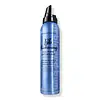What's inside
What's inside
 Key Ingredients
Key Ingredients

No key ingredients
 Benefits
Benefits

 Concerns
Concerns

 Ingredients Side-by-side
Ingredients Side-by-side

Water
Skin ConditioningIsobutane
Propane
Polyquaternium-11
Hydrolyzed Soy Protein
HumectantWheat Amino Acids
Skin ConditioningHydrolyzed Amaranth Protein
Skin ConditioningPEG-12 Dimethicone
Skin ConditioningSalix Nigra Bark Extract
Skin ProtectingPanthenol
Skin ConditioningSodium Lactate
BufferingEthylhexylglycerin
Skin ConditioningSodium PCA
HumectantAspartic Acid
MaskingPCA
HumectantArginine
MaskingAlanine
MaskingSerine
MaskingValine
MaskingProline
Skin ConditioningThreonine
Isoleucine
Skin ConditioningHistidine
HumectantPhenylalanine
MaskingCetrimonium Chloride
AntimicrobialTocopherol
AntioxidantVp/Va Copolymer
Laureth-4
EmulsifyingPEG-40 Hydrogenated Castor Oil
EmulsifyingPolyquaternium-4
Glycine
BufferingEthylhexyl Methoxycinnamate
UV AbsorberSodium Hydroxide
BufferingParfum
MaskingLinalool
PerfumingLimonene
PerfumingCitral
PerfumingCitronellol
PerfumingBenzyl Benzoate
AntimicrobialHydroxycitronellal
PerfumingCoumarin
PerfumingHexyl Cinnamal
PerfumingBHT
AntioxidantDisodium EDTA
Potassium Sorbate
PreservativePhenoxyethanol
PreservativeWater, Isobutane, Propane, Polyquaternium-11, Hydrolyzed Soy Protein, Wheat Amino Acids, Hydrolyzed Amaranth Protein, PEG-12 Dimethicone, Salix Nigra Bark Extract, Panthenol, Sodium Lactate, Ethylhexylglycerin, Sodium PCA, Aspartic Acid, PCA, Arginine, Alanine, Serine, Valine, Proline, Threonine, Isoleucine, Histidine, Phenylalanine, Cetrimonium Chloride, Tocopherol, Vp/Va Copolymer, Laureth-4, PEG-40 Hydrogenated Castor Oil, Polyquaternium-4, Glycine, Ethylhexyl Methoxycinnamate, Sodium Hydroxide, Parfum, Linalool, Limonene, Citral, Citronellol, Benzyl Benzoate, Hydroxycitronellal, Coumarin, Hexyl Cinnamal, BHT, Disodium EDTA, Potassium Sorbate, Phenoxyethanol
Ingredients Explained
These ingredients are found in both products.
Ingredients higher up in an ingredient list are typically present in a larger amount.
We don't have a description for Isobutane yet.
Parfum is a catch-all term for an ingredient or more that is used to give a scent to products.
Also called "fragrance", this ingredient can be a blend of hundreds of chemicals or plant oils. This means every product with "fragrance" or "parfum" in the ingredients list is a different mixture.
For instance, Habanolide is a proprietary trade name for a specific aroma chemical. When used as a fragrance ingredient in cosmetics, most aroma chemicals fall under the broad labeling category of “FRAGRANCE” or “PARFUM” according to EU and US regulations.
The term 'parfum' or 'fragrance' is not regulated in many countries. In many cases, it is up to the brand to define this term.
For instance, many brands choose to label themselves as "fragrance-free" because they are not using synthetic fragrances. However, their products may still contain ingredients such as essential oils that are considered a fragrance by INCI standards.
One example is Calendula flower extract. Calendula is an essential oil that still imparts a scent or 'fragrance'.
Depending on the blend, the ingredients in the mixture can cause allergies and sensitivities on the skin. Some ingredients that are known EU allergens include linalool and citronellol.
Parfum can also be used to mask or cover an unpleasant scent.
The bottom line is: not all fragrances/parfum/ingredients are created equally. If you are worried about fragrances, we recommend taking a closer look at an ingredient. And of course, we always recommend speaking with a professional.
Learn more about ParfumPhenoxyethanol is a preservative that has germicide, antimicrobial, and aromatic properties. Studies show that phenoxyethanol can prevent microbial growth. By itself, it has a scent that is similar to that of a rose.
It's often used in formulations along with Caprylyl Glycol to preserve the shelf life of products.
We don't have a description for Polyquaternium-4 yet.
Potassium Sorbate is a preservative used to prevent yeast and mold in products. It is commonly found in both cosmetic and food products.
This ingredient comes from potassium salt derived from sorbic acid. Sorbic acid is a natural antibiotic and effective against fungus.
Both potassium sorbate and sorbic acid can be found in baked goods, cheeses, dried meats, dried fruit, ice cream, pickles, wine, yogurt, and more.
You'll often find this ingredient used with other preservatives.
Learn more about Potassium SorbatePropane is a gas derived from petroleum and natural gas. It is used as a propellant.
This ingredient is most commonly used in shaving cream, hair products, and makeup.
Water. It's the most common cosmetic ingredient of all. You'll usually see it at the top of ingredient lists, meaning that it makes up the largest part of the product.
So why is it so popular? Water most often acts as a solvent - this means that it helps dissolve other ingredients into the formulation.
You'll also recognize water as that liquid we all need to stay alive. If you see this, drink a glass of water. Stay hydrated!
Learn more about Water